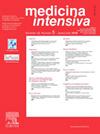去甲肾上腺素与加压素在脓毒性休克稳定期的对照:RENOVA临床试验
IF 3.1
4区 医学
Q2 CRITICAL CARE MEDICINE
引用次数: 0
摘要
目的探讨降压药脱机期低血压的发生率。在2022年5月至12月期间进行一项单中心、开放标签随机临床试验。建立三级保健学术医疗中心。患者:91例18岁以上感染性休克的成人患者(根据《败血症-3》)。患者被分为两组:初始降低去甲肾上腺素或初始降低抗利尿激素。主要观察指标为降低血管降压药后24小时内的低血压发生率 h。此外,通过死亡率、住院时间、血管加压药使用时间、心律失常发生率和血液透析患病率来评估这种低血压的临床影响。结果91例患者中,78例纳入分析:去甲肾上腺素组39例,加压素组39例。尽管两组间低血压的发生率在数值上有显著差异(去甲肾上腺素43.6%,加压素25.6%),但没有统计学差异(p = 0.153,相对风险= 1.7,95%可信区间:0.9-3.2)。在这个样本中,抗利尿激素的戒断主要是滴定的。在评估的临床结果方面,两组之间没有差异。结论去甲肾上腺素组与加压素组的低血压发生率无显著性差异,去甲肾上腺素组与加压素组的低血压发生率无显著性差异。在我们的样本中,抗利尿激素的戒断是滴定的,这与北美的做法不同。巴西临床试验注册中心(REBEC: RBR-10smbw65)。ClinicalTrials.gov平台(NCT 05506319)。本文章由计算机程序翻译,如有差异,请以英文原文为准。
Reduction of norepinephrine versus vasopressin in the stabilization phase of septic shock: RENOVA clinical trial
Objective
Evaluate the incidence of hypotension during the weaning phase of vasopressors.
Design
A single-center, open-label randomized clinical trial between May and December 2022.
Setting
a tertiary care academic medical center.
Patients
91 adult patients over 18 years of age with septic shock (according to Sepsis-3).
Intervention
Patients were divided into two groups: initial reduction of norepinephrine or initial reduction of vasopressin.
Main variables of interest
The primary outcome was the incidence of hypotension within the first 24 h after reducing vasopressors. Additionally, the clinical impact of this hypotension was assessed through mortality, length of hospital stay, duration of vasopressor use, incidence of arrhythmias, and prevalence of hemodialysis.
Results
Out of a total of 91 patients, 78 were included in the analysis: 39 in the norepinephrine group and 39 in the vasopressin group. Despite a numerically significant difference in the incidence of hypotension between the groups (norepinephrine 43.6%, vasopressin 25.6%), there was no statistical difference (p = 0.153, relative risk = 1.7, 95% confidence interval: 0.9–3.2). In this sample, vasopressin withdrawal was predominantly titrated. There were no differences between the groups in terms of the evaluated clinical outcomes.
Conclusion
No differences were detected in the incidence of hypotension when weaning was initiated with norepinephrine or vasopressin, although it was non significantly higher in norepinephrine group. In our sample, vasopressin withdrawal was titrated, which differs from North American practice. Brazilian Clinical Trials Registry (REBEC: RBR-10smbw65). ClinicalTrials.gov platform (NCT 05506319).
求助全文
通过发布文献求助,成功后即可免费获取论文全文。
去求助
来源期刊

Medicina Intensiva
CRITICAL CARE MEDICINE-
CiteScore
2.70
自引率
20.00%
发文量
146
审稿时长
33 days
期刊介绍:
Medicina Intensiva is the journal of the Spanish Society of Intensive Care Medicine and Coronary Units (SEMICYUC) and of Pan American and Iberian Federation of Societies of Intensive and Critical Care Medicine. Medicina Intensiva has become the reference publication in Spanish in its field. The journal mainly publishes Original Articles, Reviews, Clinical Notes, Consensus Documents, Images, and other information relevant to the specialty. All works go through a rigorous selection process. The journal accepts submissions of articles in English and in Spanish languages. The journal follows the publication requirements of the International Committee of Medical Journal Editors (ICMJE) and the Committee on Publication Ethics (COPE).
 求助内容:
求助内容: 应助结果提醒方式:
应助结果提醒方式:


